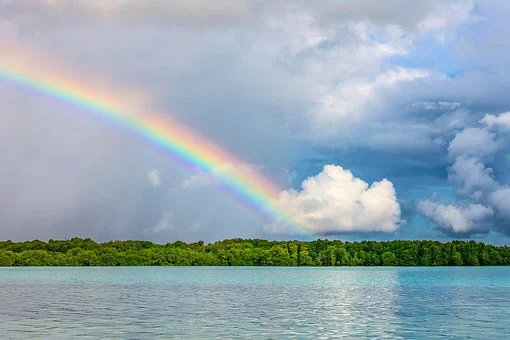Climate change to produce more rainbows

Rainbows are adorable and aesthetically pleasing. They are an important part of human culture. Rainbows generally occur when water droplets refract sunlight. This indicates that the two important factors behind the occurrence of rainbows are sunlight and water.

We are also aware of the climate change that is threatening our environment. (Please read this article: Climate Change: Threat to environment) Various human activities cause climate change resulting in adversely affecting our environment.
Keywords: rainbow, sunlight, water, climate change, Northern latitudes, aesthetic value, Flickr, The Hawaiian Islands
According to a new study, climate change will increase opportunities to view more rainbows. This study was led by researchers at the University of Hawai'i(UH) at Manoa. As per the study, researchers estimate that by 2100, the experience of the rainbow on the average Earth location will increase by 5% more days. The occurrence of rainbows will be more prominent in the Northern latitudes and very high elevations where climate change leads to more rain. However, the Mediterranean region, where climate change causes decreased rainfall is projected to experience fewer rainbow days.
The lead author of the study, Kimberly Carlson, who is now at New York University's Department of Environmental Studies said, "Living in Hawai'i, I felt grateful that stunning, ephemeral rainbows were a part of my daily life. I wondered how climate change might affect such rainbow viewing opportunities".
Camilo Mora, at the UH Manoa Geography and Environment department, said, "We often study how climate change directly affects people's health and livelihoods, for instance via the occurrence of heat stroke during climate change-enhanced heat waves".
There are numerous types of research published regarding climate change. These researchers and studies show how climate change affects the aesthetic value of our environment. But, rainbows have never been considered in these studies. For this purpose, a team including students at UH Manoa referred to Flickr ( a social media platform for uploading photos ) for looking at photographs labeled with the word "rainbow". They sorted out through thousands of uploaded photos. This helped in the identification of rainbows generated from the refraction of light by rain droplets.
Amanda Wong, an undergraduate student in Global Environmental Science at the UH Manoa School of Ocean and Earth Science and Technology (SOEST) and a co-author on the paper, said, "We had to sort through photos of rainbow artwork, rainbow flags, rainbow trout, rainbow eucalyptus, and rainbow foods to find the real rainbows".
Researchers developed a rainbow prediction model referring to the rainbow photo locations and maps of precipitation, cloud cover, and sun algae. They used this model to predict the present and future occurrences of the rainbow. This model showed that islands are hotspots of the rainbow. The Hawaiian Islands, named as "rainbow capital of the world," is estimated to have an increase of a few more days of experiencing rainbows per year.

Steven Businger, professor of Atmospheric Sciences in SOEST said, "Islands are the best places to view rainbows. This is because island terrain lifts the air during daily sea breezes, producing localized showers surrounded by clear skies that let the sun in to produce majestic rainbows".
Thus, this study shows how climate change can also prove to be aesthetically pleasing at times.
Story Source:
Materials provided by University of Hawaii at Manoa. The original text of this story is licensed under a Creative Commons License. Note: Content may be edited for style and length.
Journal Reference:
- Kimberly M. Carlson, Camilo Mora, Jinwen Xu, Renee O. Setter, Michelle Harangody, Erik C. Franklin, Michael B. Kantar, Matthew Lucas, Zachary M. Menzo, Daniele Spirandelli, David Schanzenbach, C. Courtlandt Warr, Amanda E. Wong, Steven Businger. Global rainbow distribution under current and future climates. Global Environmental Change, 2022; 77: 102604 DOI: 10.1016/j.gloenvcha.2022.102604
0 Comments